Most sound waves, including the musical sounds that actually reach our ears, are not standing waves. Normally, when something makes a wave, the wave travels outward, gradually spreading out and losing strength, like the waves moving away from a pebble dropped into a pond.
But when the wave encounters something, it can bounce (reflection) or be bent (refraction). In fact, you can “trap” waves by making them bounce back and forth between two or more surfaces. Musical instruments take advantage of this; they produce pitches by trapping sound waves.
Why are trapped waves useful for music? Any bunch of sound waves will produce some sort of noise. But to be a tone – a sound with a particular pitch – a group of sound waves has to be veryregular, all exactly the same distance apart. That’s why we can talk about the frequency and wavelength of tones.
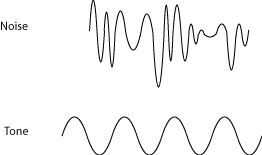 Figure 1: A noise is a
jumble of sound waves. A tone is a very regular set of waves, all the same size and same distance apart. |
So how can you produce a tone? Let’s say you have a sound
wave trap (for now, don’t worry about what it looks like), and you keep sending
more sound waves into it. Picture a lot of pebbles being dropped into a very
small pool. As the waves start reflecting off the edges of the pond, they
interfere with the new waves, making a jumble of waves that partly cancel each
other out and mostly just roils the pond – noise.
wave trap (for now, don’t worry about what it looks like), and you keep sending
more sound waves into it. Picture a lot of pebbles being dropped into a very
small pool. As the waves start reflecting off the edges of the pond, they
interfere with the new waves, making a jumble of waves that partly cancel each
other out and mostly just roils the pond – noise.
But what if you could arrange the waves so that
reflecting waves, instead of cancelling out the new waves, would reinforce them?
The high parts of the reflected waves would meet the high parts of the oncoming
waves and make them even higher. The low parts of the reflected waves would meet
the low parts of the oncoming waves and make them even lower. Instead of a
roiled mess of waves cancelling each other out, you would have a pond of
perfectly ordered waves, with high points and low points appearing regularly at
the same spots again and again. To help you imagine this, here are animations of
a single wave reflecting back and
forth and standing waves.
reflecting waves, instead of cancelling out the new waves, would reinforce them?
The high parts of the reflected waves would meet the high parts of the oncoming
waves and make them even higher. The low parts of the reflected waves would meet
the low parts of the oncoming waves and make them even lower. Instead of a
roiled mess of waves cancelling each other out, you would have a pond of
perfectly ordered waves, with high points and low points appearing regularly at
the same spots again and again. To help you imagine this, here are animations of
a single wave reflecting back and
forth and standing waves.
This sort of orderliness is actually hard to get
from water waves, but relatively easy to get in sound waves, so that several
completely different types of sound wave “containers” have been developed into
musical instruments. The two most common – strings and hollow tubes – will be
discussed below, but first let’s finish discussing what makes a good standing
wave container, and how this affects music theory.
from water waves, but relatively easy to get in sound waves, so that several
completely different types of sound wave “containers” have been developed into
musical instruments. The two most common – strings and hollow tubes – will be
discussed below, but first let’s finish discussing what makes a good standing
wave container, and how this affects music theory.
In order to get the necessary constant reinforcement, the
container has to be the perfect size (length) for a certain wavelength, so that
waves bouncing back or being produced at each end reinforce each other, instead
of interfering with each other and cancelling each other out. And it really
helps to keep the container very narrow, so that you don’t have to worry about
waves bouncing off the sides and complicating things. So you have a bunch of
regularly-spaced waves that are trapped, bouncing back and forth in a container
that fits their wavelength perfectly. If you could watch these waves, it would
not even look as if they are traveling back and forth. Instead, waves would seem
to be appearing and disappearing regularly at exactly the same spots, so these
trapped waves are called standing waves.
container has to be the perfect size (length) for a certain wavelength, so that
waves bouncing back or being produced at each end reinforce each other, instead
of interfering with each other and cancelling each other out. And it really
helps to keep the container very narrow, so that you don’t have to worry about
waves bouncing off the sides and complicating things. So you have a bunch of
regularly-spaced waves that are trapped, bouncing back and forth in a container
that fits their wavelength perfectly. If you could watch these waves, it would
not even look as if they are traveling back and forth. Instead, waves would seem
to be appearing and disappearing regularly at exactly the same spots, so these
trapped waves are called standing waves.
Note: Although standing waves are
harder to get in water, the phenomenon does apparently happen very rarely in
lakes, resulting in freak disasters. You can sometimes get the same effect by
pushing a tub of water back and forth, but this is a messy experiment; you’ll
know you are getting a standing wave when the water suddenly starts sloshing
much higher – right out of the tub!
harder to get in water, the phenomenon does apparently happen very rarely in
lakes, resulting in freak disasters. You can sometimes get the same effect by
pushing a tub of water back and forth, but this is a messy experiment; you’ll
know you are getting a standing wave when the water suddenly starts sloshing
much higher – right out of the tub!
For any narrow “container” of a particular length, there
are plenty of possible standing waves that don’t fit. But there are also many
standing waves that do fit. The longest wave that fits it is called the fundamental. It is also called the first
harmonic. The next longest wave that fits is the second
harmonic, or the first overtone. The next longest
wave is the third harmonic, or second
overtone, and so on.
are plenty of possible standing waves that don’t fit. But there are also many
standing waves that do fit. The longest wave that fits it is called the fundamental. It is also called the first
harmonic. The next longest wave that fits is the second
harmonic, or the first overtone. The next longest
wave is the third harmonic, or second
overtone, and so on.
Standing Wave Harmonics
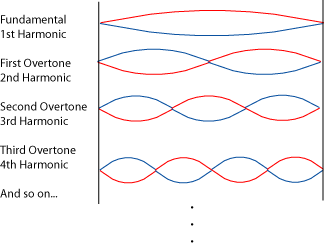 Figure 2: There is a whole
set of standing waves, called harmonics, that will fit into any “container” of a specific length. This set of waves is called a harmonic series. |
Notice that it doesn’t matter what the length of the
fundamental is; the waves in the second harmonic must be half the length of the
first harmonic; that’s the only way they’ll both “fit”. The waves of the third
harmonic must be a third the length of the first harmonic, and so on. This has a
direct effect on the frequency and pitch of harmonics, and so it affects the
basics of music tremendously. To find out more about these subjects, please see
Frequency, Wavelength, and
Pitch, Harmonic Series, or
Musical Intervals, Frequency, and
Ratio.
fundamental is; the waves in the second harmonic must be half the length of the
first harmonic; that’s the only way they’ll both “fit”. The waves of the third
harmonic must be a third the length of the first harmonic, and so on. This has a
direct effect on the frequency and pitch of harmonics, and so it affects the
basics of music tremendously. To find out more about these subjects, please see
Frequency, Wavelength, and
Pitch, Harmonic Series, or
Musical Intervals, Frequency, and
Ratio.
Standing Waves on Strings
You may have noticed an interesting thing in the animation of standing waves: there are spots where
the “water” goes up and down a great deal, and other spots where the “water
level” doesn’t seem to move at all. All standing waves have places, called nodes, where there is no wave motion, and antinodes, where the wave is largest. It is the placement of
the nodes that determines which wavelengths “fit” into a musical instrument
“container”.
the “water” goes up and down a great deal, and other spots where the “water
level” doesn’t seem to move at all. All standing waves have places, called nodes, where there is no wave motion, and antinodes, where the wave is largest. It is the placement of
the nodes that determines which wavelengths “fit” into a musical instrument
“container”.
Nodes and Antinodes
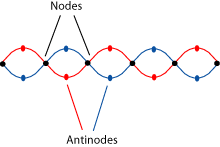 Figure 3: As a standing
wave waves back and forth (from the red to the blue position), there are some spots called nodes that do not move at all; basically there is no change, no waving up-and-down (or back-and-forth), at these spots. The spots at the biggest part of the wave – where there is the most change during each wave – are called antinodes. |
One “container” that works very well to produce standing
waves is a thin, very taut string that is held tightly in place at both ends.
(There were some nice animations of waves on strings available as of this
writing at Musemath.) Since the
string is taut, it vibrates quickly, producing sound waves, if you pluck it, or
rub it with a bow. Since it is held tightly at both ends, that means there has
to be a node at each end of the string.
Instruments that produce sound using strings are called chordophones, or simply strings.
waves is a thin, very taut string that is held tightly in place at both ends.
(There were some nice animations of waves on strings available as of this
writing at Musemath.) Since the
string is taut, it vibrates quickly, producing sound waves, if you pluck it, or
rub it with a bow. Since it is held tightly at both ends, that means there has
to be a node at each end of the string.
Instruments that produce sound using strings are called chordophones, or simply strings.
Standing Waves on a String
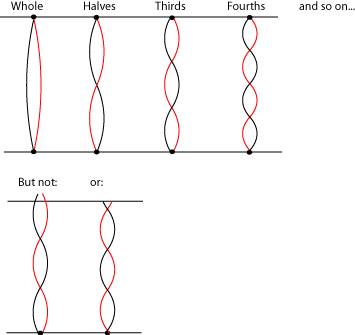 Figure 4: A string that’s
held very tightly at both ends can only vibrate at very particular wavelengths. The whole string can vibrate back and forth. It can vibrate in halves, with a node at the middle of the string as well as each end, or in thirds, fourths, and so on. But any wavelength that doesn’t have a node at each end of the string, can’t make a standing wave on the string. To get any of those other wavelengths, you need to change the length of the vibrating string. That is what happens when the player holds the string down with a finger, changing the vibrating length of the string and changing where the nodes are. |
The fundamental wave is the
one that gives a string its pitch. But the string is making all those
other possible vibrations, too, all at the same time, so that the actual
vibration of the string is pretty complex. The other vibrations (the ones that
basically divide the string into halves, thirds and so on) produce a whole
series of harmonics. We don’t hear the harmonics as
separate notes, but we do hear them. They are what gives the string its rich,
musical, string-like sound – its timbre. (The sound of a single frequency
alone is a much more mechanical, uninteresting, and unmusical sound.) To find
out more about harmonics and how they affect a musical sound, see Harmonic Series.
one that gives a string its pitch. But the string is making all those
other possible vibrations, too, all at the same time, so that the actual
vibration of the string is pretty complex. The other vibrations (the ones that
basically divide the string into halves, thirds and so on) produce a whole
series of harmonics. We don’t hear the harmonics as
separate notes, but we do hear them. They are what gives the string its rich,
musical, string-like sound – its timbre. (The sound of a single frequency
alone is a much more mechanical, uninteresting, and unmusical sound.) To find
out more about harmonics and how they affect a musical sound, see Harmonic Series.
Problem 1When the string player puts a finger
down tightly on the string,
down tightly on the string,
- How has the part of the string that vibrates changed?
- How does this change the sound waves that the string makes?
- How does this change the sound that is heard?
Solution 1
- The part of the string that can vibrate is shorter. The finger
becomes the new “end” of the string. - The new sound wave is shorter, so its frequency is higher.
- It sounds higher; it has a higher pitch.
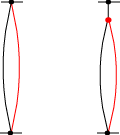 Figure 5: When a finger
holds the string down tightly, the finger becomes the new end of the vibrating part of the string. The vibrating part of the string is shorter, and the whole set of sound waves it makes is shorter. |
Standing Waves in Wind Instruments
The string disturbs the air molecules around it as it
vibrates, producing sound waves in the air. But another great container for
standing waves actually holds standing waves of air inside a long, narrow tube.
This type of instrument is called an aerophone, and the most well-known of
this type of instrument are often called wind instruments because, although the
instrument itself does vibrate a little, most of the sound is produced by
standing waves in the column of air inside the instrument.
vibrates, producing sound waves in the air. But another great container for
standing waves actually holds standing waves of air inside a long, narrow tube.
This type of instrument is called an aerophone, and the most well-known of
this type of instrument are often called wind instruments because, although the
instrument itself does vibrate a little, most of the sound is produced by
standing waves in the column of air inside the instrument.
If it is possible, have a reed player and a brass player
demonstrate to you the sounds that their mouthpieces make without the
instrument. This will be a much “noisier” sound, with lots of extra frequencies
in it that don’t sound very musical. But, when you put the mouthpiece on an
instrument shaped like a tube, only some of the sounds the mouthpiece makes are
the right length for the tube. Because of feedback from the instrument, the only
sound waves that the mouthpiece can produce now are the ones that are just the
right length to become standing waves in the instrument,
and the “noise” is refined into a musical tone.
demonstrate to you the sounds that their mouthpieces make without the
instrument. This will be a much “noisier” sound, with lots of extra frequencies
in it that don’t sound very musical. But, when you put the mouthpiece on an
instrument shaped like a tube, only some of the sounds the mouthpiece makes are
the right length for the tube. Because of feedback from the instrument, the only
sound waves that the mouthpiece can produce now are the ones that are just the
right length to become standing waves in the instrument,
and the “noise” is refined into a musical tone.
Standing Waves in Wind Instruments
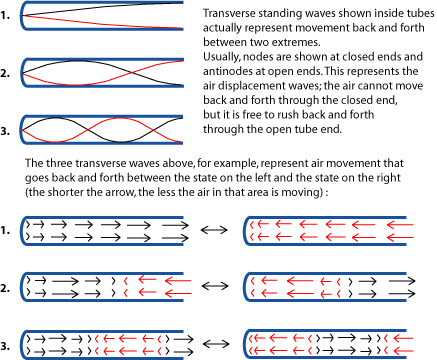 Figure 6: Standing Waves in
a wind instrument are usually shown as displacement waves, with nodes at closed ends where the air cannot move back-and-forth. |
The standing waves in a wind instrument are a little
different from a vibrating string. The wave on a string is a transverse wave, moving the string back and forth, rather than
moving up and down along the string. But the wave inside a tube, since it is a
sound wave already, is a longitudinal wave; the waves do
not go from side to side in the tube. Instead, they form along the length of the
tube.
different from a vibrating string. The wave on a string is a transverse wave, moving the string back and forth, rather than
moving up and down along the string. But the wave inside a tube, since it is a
sound wave already, is a longitudinal wave; the waves do
not go from side to side in the tube. Instead, they form along the length of the
tube.
Longitudinal Waves in Pipes
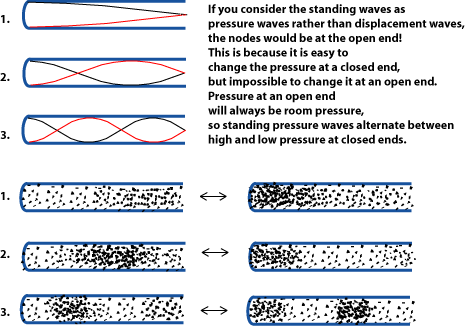 Figure 7: The standing
waves in the tubes are actually longitudinal sound waves. Here the displacement standing waves in Figure 6 are shown instead as longitudinal air pressure waves. Each wave would be oscillating back and forth between the state on the right and the one on the left. See Standing Waves in Wind Instruments for more explanation. |
The harmonics of wind instruments are also a little more
complicated, since there are two basic shapes (cylindrical and conical) that are useful for wind
instruments, and they have different properties. The standing-wave tube of a
wind instrument also may be open at both ends, or it may be closed at one end
(for a mouthpiece, for example), and this also affects the instrument. Please
see Standing Waves in Wind
Instruments if you want more information on that subject. For the purposes
of understanding music theory, however, the important thing about standing waves
in winds is this: the harmonic series they produce is essentially the same as
the harmonic series on a string. In other words, the second harmonic is still
half the length of the fundamental, the third harmonic is one third the length,
and so on. (Actually, for reasons explained in Standing Waves in Wind Instruments, some
harmonics are “missing” in some wind instruments, but this mainly affects the timbre and some aspects of playing
the instrument. It does not affect the basic relationships in the harmonic
series.)
complicated, since there are two basic shapes (cylindrical and conical) that are useful for wind
instruments, and they have different properties. The standing-wave tube of a
wind instrument also may be open at both ends, or it may be closed at one end
(for a mouthpiece, for example), and this also affects the instrument. Please
see Standing Waves in Wind
Instruments if you want more information on that subject. For the purposes
of understanding music theory, however, the important thing about standing waves
in winds is this: the harmonic series they produce is essentially the same as
the harmonic series on a string. In other words, the second harmonic is still
half the length of the fundamental, the third harmonic is one third the length,
and so on. (Actually, for reasons explained in Standing Waves in Wind Instruments, some
harmonics are “missing” in some wind instruments, but this mainly affects the timbre and some aspects of playing
the instrument. It does not affect the basic relationships in the harmonic
series.)
Standing Waves in Other Objects
So far we have looked at two of the four main groups of
musical instruments: chordophones and aerophones. That leaves membranophones and idiophones. Membranophones are instruments in which the sound is produced
by making a membrane vibrate; drums are the most familiar example. Most drums do
not produce tones; they produce rhythmic “noise” (bursts of irregular waves).
Some drums do have pitch, due
to complex-patterned standing waves on the membrane that are reinforced in the
space inside the drum. This works a little bit like the waves in tubes, above,
but the waves produced on membranes, though very interesting, are too complex to
be discussed here.
musical instruments: chordophones and aerophones. That leaves membranophones and idiophones. Membranophones are instruments in which the sound is produced
by making a membrane vibrate; drums are the most familiar example. Most drums do
not produce tones; they produce rhythmic “noise” (bursts of irregular waves).
Some drums do have pitch, due
to complex-patterned standing waves on the membrane that are reinforced in the
space inside the drum. This works a little bit like the waves in tubes, above,
but the waves produced on membranes, though very interesting, are too complex to
be discussed here.
Idiophones are instruments in
which the body of the instrument itself, or a part of it, produces the original
vibration. Some of these instruments (cymbals, for example) produce simple
noise-like sounds when struck. But in some, the shape of the instrument –
usually a tube, block, circle, or bell shape – allows the instrument to ring
with a standing-wave vibration when you strike it. The standing waves in these
carefully-shaped-and-sized idiophones – for example, the blocks on a xylophone –
produce pitched tones, but again, the patterns of standing waves in these
instruments are a little too complicated for this discussion. If a percussion
instrument does produce pitched sounds, however, the reason, again, is that it
is mainly producing harmonic-series overtones.
which the body of the instrument itself, or a part of it, produces the original
vibration. Some of these instruments (cymbals, for example) produce simple
noise-like sounds when struck. But in some, the shape of the instrument –
usually a tube, block, circle, or bell shape – allows the instrument to ring
with a standing-wave vibration when you strike it. The standing waves in these
carefully-shaped-and-sized idiophones – for example, the blocks on a xylophone –
produce pitched tones, but again, the patterns of standing waves in these
instruments are a little too complicated for this discussion. If a percussion
instrument does produce pitched sounds, however, the reason, again, is that it
is mainly producing harmonic-series overtones.
Note: Although percussion specializes in “noise”-type
sounds, even instruments like snare drums follow the basic physics rule of
“bigger instrument makes longer wavelengths and lower sounds”. If you can,
listen to a percussion player or section that is using snare drums, cymbals, or
other percussion of the same type but different sizes. Can you hear the
difference that size makes, as opposed to differences in timbre produced by different types of
drums?
sounds, even instruments like snare drums follow the basic physics rule of
“bigger instrument makes longer wavelengths and lower sounds”. If you can,
listen to a percussion player or section that is using snare drums, cymbals, or
other percussion of the same type but different sizes. Can you hear the
difference that size makes, as opposed to differences in timbre produced by different types of
drums?
Problem 2
Some idiophones, like gongs, ring at many different
pitches when they are struck. Like most drums, they don’t have a particular
pitch, but make more of a “noise”-type sound. Other idiophones, though, like
xylophones, are designed to ring at more particular frequencies. Can you think
of some other percussion instruments that get particular pitches? (Some can get
enough different pitches to play a tune.)
pitches when they are struck. Like most drums, they don’t have a particular
pitch, but make more of a “noise”-type sound. Other idiophones, though, like
xylophones, are designed to ring at more particular frequencies. Can you think
of some other percussion instruments that get particular pitches? (Some can get
enough different pitches to play a tune.)
There are many, but here are some of the most familiar:
- Chimes
- All xylophone-type instruments, such as marimba, vibraphone, and
glockenspiel - Handbells and other tuned bells
- Steel pan drums
Original Article CNX.org
